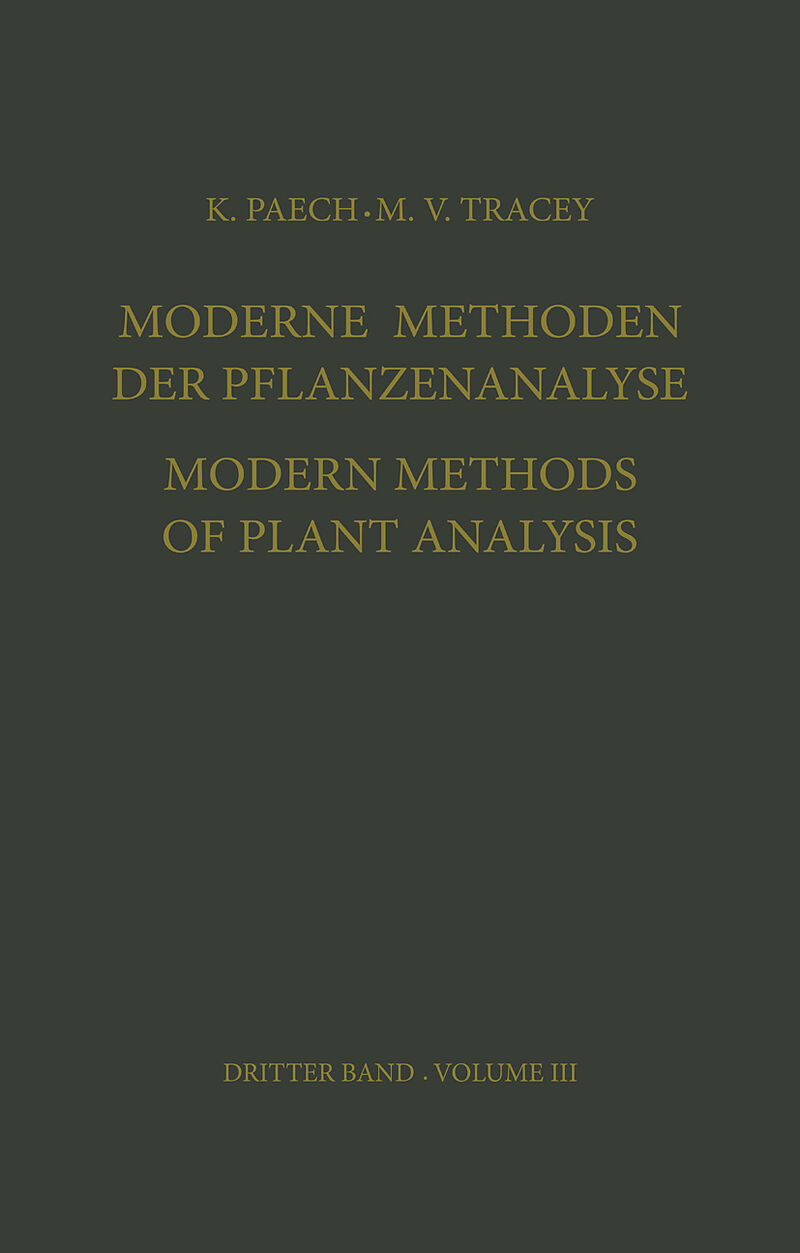Moderne Methoden der Pflanzenanalyse / Modern Methods of Plant Analysis
Einband:
E-Book (pdf)
EAN:
9783642649585
Genre:
Botanik
Autor:
K. Paech, M. V. Tracey
Herausgeber:
Springer Berlin
Auflage:
1955
Anzahl Seiten:
762
Erscheinungsdatum:
06.12.2012
If, following the solvent extraction of a hydrocarbon from a plant, it is not known whether it is one or the other, a method of distinguishing the two is described by HENDRICKS, WILDMAN and JONES (1946). The technique involves the infra-red absorption spectra of the two isomers. At about 12 mp. the relative absorption coefficient of rubber is 42% greater than for gutta. ScHLESINGER and LEPER (1951) describe two procedures for separation of the rubber and gutta hydrocarbons from large quantities of crude chicle. In one, the chicle is extracted with benzene which dissolves both isomers. An excess absolute ethyl acetate is added and the mixture stored at 5° C overnight. The gutta precipitates out and the rubber remains in solution. The other method is as follows: (1) Ten grams of chicle are extracted with acetone for 24 hours in a Soxhlet extraction apparatus. (2) The insoluble material in the thimble is allowed to .. it dry, then immersed in 150 ml. of cold Skellysolve B in a refrigerator at 10° C and· allowed to stand for 48 hours with occasional agitation. (3) The thimble is then removed from the solvent and the enclosed residue washed several times with fresh, cold Skellysolve B. (4) An excess of acetone and a few drops of a concentrated aqueous solution of sodium iodide are added to the combined Skellysolve B extract and washings and allowed to stand overnight in a refrigerator.
Inhalt
Contents.- Die niederen Terpene (ätherische Öle und Harze allgemein).- Gebietsumgrenzung.- A. Qualitative Nachweismethoden für Duftöle und Harze im pflanzlichen Material..- B. Quantitative Methoden zur Bestimmung. des Duftölgehaltes in Pflanzenmaterial.- C. Quantitative Methoden zur Bestimmung des Harzgehaltes von Pflanzenteilen.- D. Untersuchung isolierter ätherischer Öle und Harze.- Literatur.- Pyrethrins and Allied Compounds..- A. Distribution.- B. Active Principles.- C. Analysis.- References.- Triterpene und Triterpen-Saponine.- A. Einleitung und Übersicht.- B. Zur Biogenese und Physiologie der Triterpene.- C. Qualitative Nachweismethoden für Triterpene.- D. Methoden zum Nachweis und zur Gehaltsbestimmung von Saponinen.- E. Methoden zur Isolierung und Kennzeichnung der Triterpene und einiger Saponine.- Literatur.- Phytosterine, Steroidsaponine und Herzglykoside...- A. Phytosterine.- V. Vorkommen und Eigenschaften einzelner Phytosterine.- Literatur.- B. Steroidsaponine.- Literatur.- C. Herzglykoside.- Literatur.- Carotinoids ..- A. General Distribution of C40-Carotenoids.- B. Separation and Identification.- C. Isolation and Identification of Pigments.- D. Quantitative Determination of Carotenoids.- E. Carotenoids Containing Less than 40 Carbon Atoms.- References.- The Determination of Rubbrer and Gutta in Plants.- A. Chemical and Physical Properties.- B. Occurrence.- C. Methods of Analysis.- D. Summary.- References.- Simple Benzene Derivatives..- A. Distribution and Properties of Phenols.- B. Qualitative Tests for Phenols.- C. Identification of Phenols.- D. Quantitative Determination of Phenols.- E. Aromatic Acids.- References.- Natural Tropolones.- References.- Ein- un zweikernige Chinone.- A. Vorkommen und Verteilung ein- und zweikerniger Chinone inPflanzen.- B. Isolierung von Chinonen aus biologischen Materialien.- C. Allgemeine Analytik chinoider Stoffe.- D. Die einzelnen bisher aus Pflanzen isolierten ein- und zweikernigen Chinone und ihre wichtigsten analytischen Daten.- E. Vitamin K1.- Literatur.- Natural Phenylpropane Derivatives..- A. Introduction.- B. Hydrocarbons.- C. Alcohols.- D. Acids.- E. Esters.- F. Aldehydes.- G. Ketones.- H. Phenols.- I. Phenol Ethers.- References.- Lignans.- I. General Structure and Theory of Biosynthesis.- II. Isolation and Purification of Lignans.- References.- Anthocyanins, Chalcones, Aurones, Flavones and Related Water-Soluble Plant Pigments.- A. The Distribution of Flavonoid Compounds in Nature.- B. The Isolation of Flavonoid Compounds from Plant Materials.- C. Identification by Color Reactions.- D. Analysis by Chromatographic Methods.- E. Absorption Spectra of Flavonoid Compounds.- F. Polarographie Analysis of Flavonoid Compounds.- References.- Lignin.- A. Das Lignin in der Pflanze.- B. Zur Chemie des Lignins.- C. Isolierung und Bestimmung des Lignins.- Literatur.- Natürliche Gerbstoffe.- A. Übersicht und Einteilung.- B. Allgemeine Eigenschaften.- C. Qualitative analytische Untersuchung.- D. Quantitative Analyse.- E. Beispiele für die präparative Darstellung von natürlichen Gerbstoffen.- Literatur.- Anthraglykoside und Dianthrone.- A. Vorkommen und Eigenschaften.- B. Konstitution und Bestimmung.- Literatur.- Growth Substances in Higher Plants.- A. Extraction of Growth Substances.- B. Release of Bound Auxin and Conversion of Auxin Precursors.- C. Fractionation of Extracts.- D. Isolation of Growth Substances in Pure Form.- E. Biological Tests.- F. Colorimetric Methods for the Determination of Indole-3-Acetic Acid.- G. Identification of Growth Substances.-References.- Antibiotics.- A. Introduction.- B. Historical.- C. The Detection of Antibiotic Substances in Plant Tissues and the Assay of Active Preparations.- D. Plants which Yield Antibiotically-active Preparations.- E. Antibiotic Compounds and Groups of Compounds of Wide Distribution in Higher Plante.- References.- Sachverzeichnis (deutsch-englisch).- Subject Index (english-german).

Leider konnten wir für diesen Artikel keine Preise ermitteln ...
billigbuch.ch sucht jetzt für Sie die besten Angebote ...
Die aktuellen Verkaufspreise von 6 Onlineshops werden in Realtime abgefragt.
Sie können das gewünschte Produkt anschliessend direkt beim Anbieter Ihrer Wahl bestellen.
Loading...
Die aktuellen Verkaufspreise von 6 Onlineshops werden in Realtime abgefragt.
Sie können das gewünschte Produkt anschliessend direkt beim Anbieter Ihrer Wahl bestellen.
| # | Onlineshop | Preis CHF | Versand CHF | Total CHF | ||
|---|---|---|---|---|---|---|
| 1 | Seller | 0.00 | 0.00 | 0.00 |
